Frank's travels around Britain 2011.
Norfolk.
Our first trip to Norfolk.
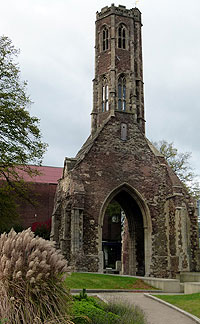 It started damp in the second week of October but true to form, nothing was
doing to dampen our spirits. It was going to be a long journey, so we decided to split
it into chunks. As usual, our first stop being a hearty breakfast at Morrison's
superstore
in Wetherby & then on to Kings Lynn to get photos & see one of the places
that Cynthia's ancestors come from.
It started damp in the second week of October but true to form, nothing was
doing to dampen our spirits. It was going to be a long journey, so we decided to split
it into chunks. As usual, our first stop being a hearty breakfast at Morrison's
superstore
in Wetherby & then on to Kings Lynn to get photos & see one of the places
that Cynthia's ancestors come from.
Cynthia said she knew we had reached Norfolk when she saw a tourist sign for
the "Weavers Way" car park, and as we passed slowly, it said "unsuitable for
motor cars". Mind you that was nothing compared to the map in the Caister on
the sea front car park .. but more about that later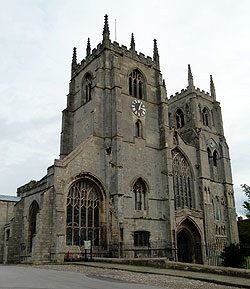 !
!
Once you pass over the bridge into Kings Lynn, the scenery changes from detached houses separated by sugar beet fields to a town that goes back to the 10th century. Lynn (as it was known originally) began as a settlement on a constricted site to the south of the mouth of the River Great Ouse. Development began in the early 10th century, but was not recorded until the early 11th century, but during the reign of Henry VIII, it was surrendered to the crown, and it then assumed the name of Lenne Regis, or King's Lynn. The centre is beautiful with the remains of Greyfriars Tower sitting close to St. Margaret's Church, the place we have come to photograph.
Greyfriars Tower is the last significant remaining part of a priory established in the 1230's by a group of Franciscan Friars (followers of St Francis of Assisi). Of the 60 Franciscan priories that existed in England, prior to the suppression in 1538, significant remains of only 16 exist. Greyfriars Tower is one of only 3 remaining towers in the country, and is the most attractive and complete. The tower is a key landmark in King's Lynn and it owes its survival to this as, for centuries, it proved useful as a seamark for traders and sailors navigating the difficult waters of The Wash.
St. Margaret's church was of personal interest to Cynthia as
her 5 x great
grandparents were married there in 1767. It seems a long time ago but this
church was started around 1101. Serious damage occurred to the church in
1741, when a great storm destroyed the spires of St Margaret's church and St
Nicholas' Chapel as well as St Margaret's central lantern (The Lantern tower
allows the center of the church to be illuminated with natural daylight). Despite generous
donations totaling £1,000 from George
II and Robert
Walpole, the £3,500 required was not raised, and the church was not able
to be restored to its former glory.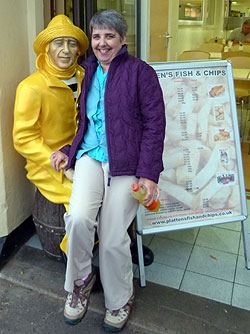
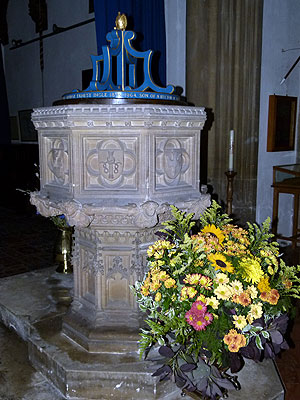 From Kings Lynn, via many sugar beet fields, distant square towered churches
& a few decapitated windmills, we made our way to St. Nicholas Parish church
at Wells next the Sea. This was where Cynthia's 3 x grandmother was baptized
in 1808. The towns name is Guella in the Domesday
Book (half gallicised,
half Latinised from the Anglian Wella, a spring). This derives from spring wells of which Wells
used to have many, rising through the chalk of the area. The town started to
be known as Wells-next-the-Sea in the early 19th century to distinguish it
from other places of the same name. The church burned after a lightning
strike in 1879: the exterior shows the original stonework, but the interior
is sparse and flat with plain glass in its windows, this seems to have been
only of interest to people called Loynes! Its claim to fame must be that John
Fryer, Captain Bligh's sailing
master on HMS Bounty was
born at Wells, and is buried in the churchyard.
From Kings Lynn, via many sugar beet fields, distant square towered churches
& a few decapitated windmills, we made our way to St. Nicholas Parish church
at Wells next the Sea. This was where Cynthia's 3 x grandmother was baptized
in 1808. The towns name is Guella in the Domesday
Book (half gallicised,
half Latinised from the Anglian Wella, a spring). This derives from spring wells of which Wells
used to have many, rising through the chalk of the area. The town started to
be known as Wells-next-the-Sea in the early 19th century to distinguish it
from other places of the same name. The church burned after a lightning
strike in 1879: the exterior shows the original stonework, but the interior
is sparse and flat with plain glass in its windows, this seems to have been
only of interest to people called Loynes! Its claim to fame must be that John
Fryer, Captain Bligh's sailing
master on HMS Bounty was
born at Wells, and is buried in the churchyard.
Wells other claim to fame may be the price of it's fish & chips! The harbour is very attractive & well worth a visit but resist if you can, the smell of fish & chips from across the road. Frank couldn't, Cynthia consented (and did her famous battered fish unzipping) & we both paid the price! It was called Plattens & looked very nice & clean. It had plenty of room to eat inside but .... the food you had to collect yourself, the plates were cardboard, the cutlery was plastic & Frank's tea was in a polystyrene cup. For all this luxury & a soft drink, we were coshed for £16:40!!!! It was generous & well cooked but on the edge of banditry for that much. Maybe it's our fault for being tourists & from the north!
Day two & the map!
Caister on sea has a unique feature neither of us had seen before.
As usual Frank got it wrong & thought that Caister was famous for it's crabs. (No Frank, that's Cromer, further up the coast) We set off to make it our first call. We found an excellent car park right next to the sand dunes & Life Boat Station. As a bonus it was designated "winter" and was free. We went across the dunes, through the beautiful fine sand onto the pebbly beach that stretches for miles & miles. It's wild & untamed, a really lovely part of Great Britain. "Lets go back to the car park & look at the map. We can plan where to go in Caister" says Frank.
As the map hadn't got a "you are here" arrow, we pondered a while & thought the shopping centre or the pier would be easy to spot. We turned right to travel north & immediately left the village!

 Little
did we know that there wasn't a "you are here" arrow ... because you
weren't. The shopping centre AND the pier would be even more difficult to
find as they weren't there either. Its the first car park we have ever
discovered that shows a map of another town! It was a map of Great Yarmouth
in Caister's car park. The only note about Caister, that we found on it, was
at the top. Great Yarmouth has a road called "Caister Road". Nowhere on the
map is there a note to say "For those visiting Caister, please note, this is
Great Yarmouth" .... welcome to Norfolk!
Little
did we know that there wasn't a "you are here" arrow ... because you
weren't. The shopping centre AND the pier would be even more difficult to
find as they weren't there either. Its the first car park we have ever
discovered that shows a map of another town! It was a map of Great Yarmouth
in Caister's car park. The only note about Caister, that we found on it, was
at the top. Great Yarmouth has a road called "Caister Road". Nowhere on the
map is there a note to say "For those visiting Caister, please note, this is
Great Yarmouth" .... welcome to Norfolk!
Not all is lost though. As a reward for confusing tourists, just to the north of Caister is Horsey Wind pump. A joy to see if ever there was one!
The pump is a drainage windmill. Built to replace an earlier Windmill, it was constructed around 1911. It was working until it was struck by lightning in 1943. (Up to now that's two lightning strikes & a storm that wrecks building around here. I bet they don't call it lucky Norfolk!). It was acquired by the National Trust in 1948 from the Buxton Family and has been restored. The Buxton family continue to manage the estate, emphasising nature conservation. It is a photographer's dream, even on a damp overcast day. The pleasure boats moor right up to it & there is a small gift shop & cafe right beside it. All the workings are still in there, huge wooden toothed cogs are fitted in the massive wheels. All the evidence of the carpenters work is showing in the woodwork. You can climb the three floors & take in the views across the fens. Its so worth a visit.
 We
ended our day at Felbrigg Hall, a fabulous National Trust property just
below the town of Cromer. It was getting damp, so we confined ourselves to
the interior of the house. It is an unaltered 17th-century house,
noted for its Jacobean
architecture and fine Georgian
interior. The huge lettering across the first floor of the house Gloria Deo
in Excelsis (Glory to God in the highest) dates from this Jacobean era.
We
ended our day at Felbrigg Hall, a fabulous National Trust property just
below the town of Cromer. It was getting damp, so we confined ourselves to
the interior of the house. It is an unaltered 17th-century house,
noted for its Jacobean
architecture and fine Georgian
interior. The huge lettering across the first floor of the house Gloria Deo
in Excelsis (Glory to God in the highest) dates from this Jacobean era.
Felbrigg estate, originally home to the Felbrigg family, was long the
home of members of the Wyndham family, since the first John Wyndham (d.
1475), acquired the estate from the Felbrigg family. Thomas Wyndham (d.
1522) was a councilor to King Henry
VIII. Later
residents included John
Wyndham (1558–1645), probably the builder of Felbrigg Hall. The last
Wyndham of Felbrigg was William Wyndham (d. 1810). William Frederick,
cruelly labeled Mad Windham, was eccentric and naive. Apart from dressing as
a London policeman he also acquired a mail van and drove dangerously to
Norwich for his letters, as well as driving a coach. Exploited by
gold-diggers, crooks and shysters, he fell hopelessly into debt.  The estate
was sold to a Norwich merchant, John Ketton. It proved hard to maintain the
expensive house, and it decayed, but the family produced one remarkable
figure; Robert Windham Ketton-Cremer was a gifted amateur historian, well
worth reading for his studies of Norfolk in the Civil War. On his death in
1969, he left the house to the National Trust.
The estate
was sold to a Norwich merchant, John Ketton. It proved hard to maintain the
expensive house, and it decayed, but the family produced one remarkable
figure; Robert Windham Ketton-Cremer was a gifted amateur historian, well
worth reading for his studies of Norfolk in the Civil War. On his death in
1969, he left the house to the National Trust.
Whilst we toured the house, Frank made the comment "I wonder if they read all these books?" Someone did! because one of the ghost stories associated with Felbrigg centred on the phantom bibliophile. William Windham III is believed to still visit his magnificent library in order to read all the books he didn’t have time to whilst he was alive. Nearly 200 years ago a fire broke out and William risked his life trying to rescue and save precious volumes, dying weeks later from his injuries. According to reports, the ghost will only appear when an exact combination of books is placed on the library chair.
Day three & Blickling Hall.
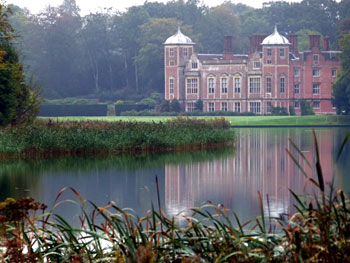
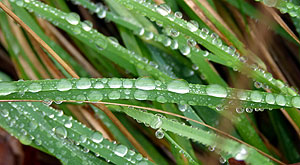 It
was getting wetter so we decided to go inside another National Trust
property. Unfortunately, it wasn't wet enough to deter us walking round the
lake first, in the hope of getting some good reflective photographs.
It
was getting wetter so we decided to go inside another National Trust
property. Unfortunately, it wasn't wet enough to deter us walking round the
lake first, in the hope of getting some good reflective photographs.
A word to
the wise ... don't, unless your very fit. There are very few
chances to show the refection of the house in the lake as it's hard to get
in the right position. You'll not have to mind walking miles
round the outside of Blickling's gardens either, due to a locked gate. It might be nice in the sunshine
but it nearly did us both in! By the time we were half way round, the
drizzle started, that developed into rain & we were in danger of rusting.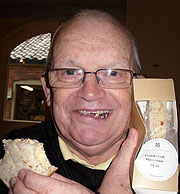
The lake is stunning & huge. We had a chat with the game warden, who was checking on the two fisherman they had that day. There were tales of pulling 41Ib carp out of the lake and just how full of wildlife the grounds are. Only that morning a fisherman had seen otters swimming around.
It was a bit annoying to find that the gate access, which was close to the house gardens, was locked. It turned out that we were only half way round, wet through & tired already! There was no point in turning round, as pilots say on mid ocean crossing, we had past the point of no return! Wet & sodden, we finally arrived at the house and took refuge in the restaurant. A cup of tea & a crab sandwich (Frank had promised himself one on this trip) was never so well received. Poor Cynthia was stuck with a packet of crisps because of her dietary restrictions. Luckily, we'd had a huge Crown Carvery breakfast & she wasn't as starving as greedy Frank. Steaming up with the humidity & warmth of the restaurant we must have looked a sight. Mind you, there were a few others in distictly damp condition.
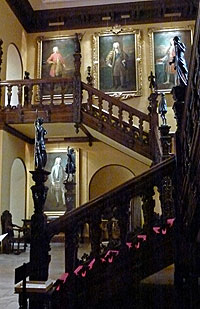 In the fifteenth century, Blickling Hall was in the possession of Sir
John Fastolf of Caister in Norfolk (1380–1459), who made a fortune in
the Hundred Years'
War, and whose coat of arms is still on display there. Later, the Hall
was in the possession of the Boleyn family, and home to Sir Thomas
Boleyn, created Earl of Wiltshire, and his wife, Elizabeth,
between 1499 and 1505. It is presumed that their first two children Mary and George were
born at Blickling Hall, along with several other Boleyn infants who did not
live long. If the couple's most famous child, Anne
Boleyn, was born before 1505 (as one school of historical thought
contends) then she too was born at Blickling. Other historians maintain that
Anne was born after 1505, probably in 1507, and by that time Sir Thomas had
moved to Hever Castle in Kent.
Nonetheless, a statue and portrait of Anne
Boleyn reside in Blickling Hall claiming "Anna Bolena hic nata 1507"
(Anne Boleyn born here 1507). The current Blickling Hall was built on the
ruins of the old Boleyn property in the reign of James
I, by Sir Henry
Hobart,
Chief Justice of the Common Pleas and 1st Baronet, who bought Blickling
from Robert Clere in 1616.
In the fifteenth century, Blickling Hall was in the possession of Sir
John Fastolf of Caister in Norfolk (1380–1459), who made a fortune in
the Hundred Years'
War, and whose coat of arms is still on display there. Later, the Hall
was in the possession of the Boleyn family, and home to Sir Thomas
Boleyn, created Earl of Wiltshire, and his wife, Elizabeth,
between 1499 and 1505. It is presumed that their first two children Mary and George were
born at Blickling Hall, along with several other Boleyn infants who did not
live long. If the couple's most famous child, Anne
Boleyn, was born before 1505 (as one school of historical thought
contends) then she too was born at Blickling. Other historians maintain that
Anne was born after 1505, probably in 1507, and by that time Sir Thomas had
moved to Hever Castle in Kent.
Nonetheless, a statue and portrait of Anne
Boleyn reside in Blickling Hall claiming "Anna Bolena hic nata 1507"
(Anne Boleyn born here 1507). The current Blickling Hall was built on the
ruins of the old Boleyn property in the reign of James
I, by Sir Henry
Hobart,
Chief Justice of the Common Pleas and 1st Baronet, who bought Blickling
from Robert Clere in 1616.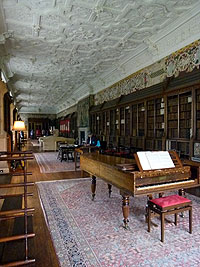
It is said that every year, on the anniversary of her execution, Anne Boleyn's headless ghost arrives at Blickling Hall in a carriage driven by an equally headless coachman. But she hasn't lost her head completely in the afterlife—she carries it along with her during her hauntings. Mind you, Ann's ghost turns up in other places! She is claimed by the Tower of London and Windsor Castle. Her brother & father are said to haunt Blickling Hall too, so it recently topped a National Trust poll as the Trust's Most Haunted Building.
The interior is most impressive, & its
now so good that the National Trust allow
you to take photographs inside their properties, as long as you don't use flash. One of the really fine
rooms is the Long Gallery. These were often put into wooden houses & the
weight caused all sorts of problems but here in Blickling, the stone work
copes brilliantly. A Long gallery is an architectural term given to a long,
narrow room, often with a high ceiling. In British architecture, long
galleries were popular in Elizabethan and Jacobean houses.
They were often located on the upper floor of the great houses of the time,
and stretched across the entire frontage of the building. They served
several purposes: among others, they were used for entertaining guests, for
taking exercise in the form of walking when the weather was inclement, and
for displaying art collections.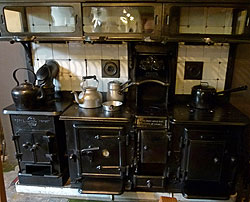
Below stairs has two of the main servants giving their audio memories from their time in the 1930's. Mr. Burgess was the butler & Mrs. O'Sullivan the House Keeper. It's very effective but to old people like Frank, that wasn't a long time ago! The whole of the kitchens seem frozen in the time of these people. In one room was an old Aga!
Downstairs, near the entrance is an RAF exhibition. During World War II the house was requisitioned and served as the Officers Mess of nearby RAF Oulton (nothing is too good for the officers!). It was full of small mementoes, photos & the odd uniforms. A nice touch, were the personal testaments from people who had been there in the war years, not just the stories about officers but I saw the memories of a humble Leading Aircraftman's wedding. Oulton was grass airfield for light bombers for the RAF & it looks like the USAF moved in with fortresses in September 1943 after the airfield got concrete runways. It would be after the war that the house and its estate passed to The National Trust, under the terms of the Country Houses scheme.
On to silly Thursday & the meeting of friends.
 After breakfast & a stroll by the river Yare, we were due to call on
friends we had made on our web forum. It turned out to be our best day ever!
After breakfast & a stroll by the river Yare, we were due to call on
friends we had made on our web forum. It turned out to be our best day ever!
We soon became aware that Sue is as mad as a box of frogs & surely Rodders must be too ... he married her! So long as there isn't a competition to decide WHO is the maddest between the four of us ... no one would know who the winner would be for sure!
More friendly people will be hard to find. Hospitable, generous & full of fun. Rod has a special advantage for us, he was a taxi controller in Norwich (pronounced Norridge!). This man knew exactly where to take us. When you follow Rod, you find out how beautiful Norridge is.
After a brew & the girls talking twenty to the dozen, Rod came back with Stanley the dog. Now Stanley is not keen on men, & Frank, being very strange, wasn't Stanley's favourite person. He did relent & sat on Cynthia's lap. OK, not for long, but he did do it. We were also introduced to Stanley's best friend, Holly. They run at breakneck speed between each others houses. It's all very suitable for a mad household.
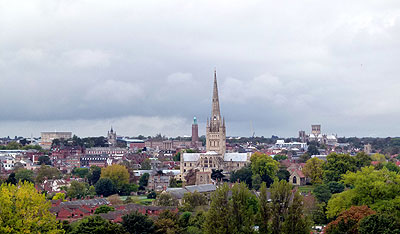 We set off to a great viewing spot that Rod knew (that mans knows
EVERYWHERE). It is just by Norwich prison on St James Hill in Mousehold
Heath, it overlooks the entire city. You can
see the Castle and both cathedrals from a rare high spot in such a flat
county.
We set off to a great viewing spot that Rod knew (that mans knows
EVERYWHERE). It is just by Norwich prison on St James Hill in Mousehold
Heath, it overlooks the entire city. You can
see the Castle and both cathedrals from a rare high spot in such a flat
county.
Rod then took us to a car park near the Anglican Cathedral that also
boasts the Adam & Eve, the oldest pub in Norwich, and maybe in England.
First recorded as an alehouse in 1249, and frequented by the stone-masons
building the nearby Norwich Cathedral (that was 900 years ago). 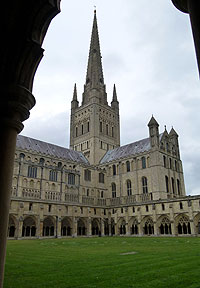 The monks
who owned the building also gave its ale to their patients at the historic
Great Hospital. It witnessed bitter battles during Kett's Rebellion in 1549,
when an army of insurgents briefly took the city. The ghost of Lord
Sheffield - hacked to death by rebels nearby - is reputed to still haunt the
building. It is thought to have roots back 1500 years ago.
The monks
who owned the building also gave its ale to their patients at the historic
Great Hospital. It witnessed bitter battles during Kett's Rebellion in 1549,
when an army of insurgents briefly took the city. The ghost of Lord
Sheffield - hacked to death by rebels nearby - is reputed to still haunt the
building. It is thought to have roots back 1500 years ago.
Norwich is known for its numerous medieval churches. It’s second to London for having the most number of medieval churches in the whole country.
We moved through the streets towards the cathedral, Sue doing her hop scotch routine & a very brief pole dance on a county council lamppost! Being a really good friend, Cynthia videoed her & promptly posted it on our chat site for all to see. There isn't a cat in hells chance of us being invited back, that's for sure!
As atheists both Cynthia & Frank were truly impressed with the Cathedral, Sue let it be known it was her first visit too! There was live music being played by school children, it sounded so good, even if a few bum notes were played. The whole place is very easy to walk around without disturbing anyone. Its full of amazing detail & we were all captivated.
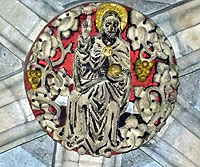 The cathedral was started in 1096 and constructed out of flint and mortar
and faced with a cream coloured Caen limestone. A Saxon settlement and two
churches were demolished to make room for the buildings. The building was
finished in 1145 and had the fine Norman tower, that we see today, topped
with a wooden spire covered with lead. Several periods of damage caused
rebuilding to the nave and spire but after many years the building was much
as we see it now, from the final erection of the stone spire in 1480.
Standing at 315 feet, the cathedral's spire is the second tallest in
England, and dominates the city skyline — only the spire of Salisbury
Cathedral is higher at 404 feet.
The cathedral was started in 1096 and constructed out of flint and mortar
and faced with a cream coloured Caen limestone. A Saxon settlement and two
churches were demolished to make room for the buildings. The building was
finished in 1145 and had the fine Norman tower, that we see today, topped
with a wooden spire covered with lead. Several periods of damage caused
rebuilding to the nave and spire but after many years the building was much
as we see it now, from the final erection of the stone spire in 1480.
Standing at 315 feet, the cathedral's spire is the second tallest in
England, and dominates the city skyline — only the spire of Salisbury
Cathedral is higher at 404 feet.
The whole place is full of fascinating detail, Frank liked the detail in the ceiling bosses. They are so like the one in Lacock Abbey in Wiltshire. All finely carved & painted, there are so many to see, you risk getting a severe crick in the neck!
What we needed was a a little light lunch. Sue & Rodders chose the Glass House, just by the older part of the city. What a pity they didn't have any staff, a person could have died just waiting for the service to start. When the very polite guy turned up, Frank managed to order the meals in two halves, they watched us eat while we took our turn at watching later. It was very nice & as it took a long time to complete, the conversation got dafter. We'll expect nothing else from now on!
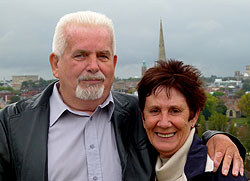 Next it was on to the old part of the city around Elm Hill. It's close to
the river & the cathedral. Cobbled streets full of buildings leaning, signs
that said "The monastery" & quaint tea shops that sold loose leaf tea to die
for! We were SO lucky to find a spot to park. Any other day, I would have
thought we'd have to park miles away.
Next it was on to the old part of the city around Elm Hill. It's close to
the river & the cathedral. Cobbled streets full of buildings leaning, signs
that said "The monastery" & quaint tea shops that sold loose leaf tea to die
for! We were SO lucky to find a spot to park. Any other day, I would have
thought we'd have to park miles away.
The Tea House is in Wrights Court, the only remaining example of a residential court leading off Elm Hill. Several families would live in each house, sharing a water pump & a privvy. Its now the haunt of tourists seeking a better cuppa with a tasty morsel on the side & the middle classes looking for antiques.
It was the end of a really pleasant day. Good company, lots of laughter & a proper guide to see us around Norridge!
Final trek home & The Workhouse.
 It was going to be a long journey back. We had promised ourselves a visit
to The Workhouse in Southwell, Nottinghamshire. It is the most complete
workhouse in existence and was both the first, and the last to be used in
the country. It was built in 1824, introducing a harsh system
designed to cut the cost of caring for the poor.
It was going to be a long journey back. We had promised ourselves a visit
to The Workhouse in Southwell, Nottinghamshire. It is the most complete
workhouse in existence and was both the first, and the last to be used in
the country. It was built in 1824, introducing a harsh system
designed to cut the cost of caring for the poor.
The workhouses were feared by the poor and old. The government, terrified of encouraging 'idlers', made sure that people feared the workhouse and would do anything to keep out of it.
Women, children and men had different living and working areas in the workhouse, so all families were split up. To make things even worse they could be punished if they even tried to speak to one another! The only concession to this was on a Sunday when they met for an hour, under supervision. The education the children received did not include the two most important skills of all, reading and writing, which were needed to get a good job. They were made to wear a uniform. This meant that everyone looked the same and everyone outside knew they were poor and lived in the workhouse.
Upon entering the workhouse, the poor were stripped and bathed (under supervision). The food was deliberately tasteless and was the same day after day. Surprisingly, they were not starved ala Oliver Twist, but just bored to death!
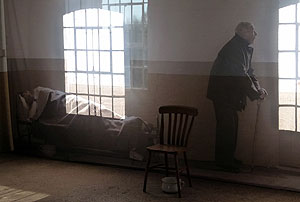 The young and old as well as men and women were made to work hard, often
doing unpleasant jobs like picking oakum, a preparation of tarred fiber
used in shipbuilding, for caulking or
packing the joints of timbers in wooden vessels and the deck planking of
iron and steel ships, as well as cast iron plumbing applications. Oakum was at one time recycled
from old tarry ropes and cordage, which were painstakingly unraveled and
taken apart into fibers; this task of picking and preparation was a common
penal occupation in prisons and workhouses.
The young and old as well as men and women were made to work hard, often
doing unpleasant jobs like picking oakum, a preparation of tarred fiber
used in shipbuilding, for caulking or
packing the joints of timbers in wooden vessels and the deck planking of
iron and steel ships, as well as cast iron plumbing applications. Oakum was at one time recycled
from old tarry ropes and cordage, which were painstakingly unraveled and
taken apart into fibers; this task of picking and preparation was a common
penal occupation in prisons and workhouses.
Children could also find themselves 'hired out' (sold) to work in factories or mines. If your remember, Charles Dickens's Oliver Twist was sold off to a funeral director. Because he was a pain, they offer him AND £5 to be taken on as an "Apprentice".
The Southwell Workhouse is very good. A film starts your tour by putting the facts about it's beginning & founder, the Reverend John Becher, before you. You then follow a path way through empty rooms decorated in the original style. It wasn't until the end, when furniture like beds & chamber pots was put in & you saw, what looked like the ghosts of past old & infirm men that it came to life.
It certainly is worth a visit.
Our trip may have been a bit damp but it ended with friendship & blazing sunshine. That's a mixture that can't do you too much ill.
Links for information on this page:
Kings Lynn
Felbrigg Hall History
Blickling Hall
History of Norwich
About all workhouses
